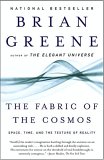Summary | Excerpt | Reviews | Readalikes | Genres & Themes | Author Bio

Critics' Opinion:
Readers' Opinion:
First Published:
Feb 2004, 592 pages
Paperback:
Feb 2005, 592 pages
To Isaac Newton, space and time simply were–they formed an inert, universal cosmic stage on which the events of the universe played themselves out. To his contemporary and frequent rival Gottfried Wilhelm von Leibniz, "space" and "time" were merely the vocabulary of relations between where objects were and when events took place. Nothing more. But to Albert Einstein, space and time were the raw material underlying reality. Through his theories of relativity, Einstein jolted our thinking about space and time and revealed the principal part they play in the evolution of the universe. Ever since, space and time have been the sparkling jewels of physics. They are at once familiar and mystifying; fully understanding space and time has become physics' most daunting challenge and sought-after prize.
The developments we'll cover in this book interweave the fabric of space and time in various ways. Some ideas will challenge features of space and time so basic that for centuries, if not millennia, they've seemed beyond questioning. Others will seek the link between our theoretical understanding of space and time and the traits we commonly experience. Yet others will raise questions unfathomable within the limited confines of ordinary perceptions.
We will speak only minimally of philosophy (and not at all about suicide and the meaning of life). But in our scientific quest to solve the mysteries of space and time, we will be resolutely unrestrained. From the universe's smallest speck and earliest moments to its farthest reaches and most distant future, we will examine space and time in environments familiar and far-flung, with an unflinching eye seeking their true nature. As the story of space and time has yet to be fully written, we won't arrive at any final assessments. But we will encounter a series of developments–some intensely strange, some deeply satisfying, some experimentally verified, some thoroughly speculative–that will show how close we've come to wrapping our minds around the fabric of the cosmos and touching the true texture of reality.
Classical Reality
Historians differ on exactly when the modern scientific age began, but certainly by the time Galileo Galilei, René Descartes, and Isaac Newton had had their say, it was briskly under way. In those days, the new scientific mind-set was being steadily forged, as patterns found in terrestrial and astronomical data made it increasingly clear that there is an order to all the comings and goings of the cosmos, an order accessible to careful reasoning and mathematical analysis. These early pioneers of modern scientific thought argued that, when looked at the right way, the happenings in the universe not only are explicable but predictable. The power of science to foretell aspects of the future–consistently and quantitatively–had been revealed.
Early scientific study focused on the kinds of things one might see or experience in everyday life. Galileo dropped weights from a leaning tower (or so legend has it) and watched balls rolling down inclined surfaces; Newton studied falling apples (or so legend has it) and the orbit of the moon. The goal of these investigations was to attune the nascent scientific ear to nature's harmonies. To be sure, physical reality was the stuff of experience, but the challenge was to hear the rhyme and reason behind the rhythm and regularity. Many sung and unsung heroes contributed to the rapid and impressive progress that was made, but Newton stole the show. With a handful of mathematical equations, he synthesized everything known about motion on earth and in the heavens, and in so doing, composed the score for what has come to be known as classical physics. In the decades following Newton's work, his equations were developed into an elaborate mathematical structure that significantly extended both their reach and their practical utility. Classical physics gradually became a sophisticated and mature scientific discipline. But shining clearly through all these advances was the beacon of Newton's original insights. Even today, more than three hundred years later, you can see Newton's equations scrawled on introductory-physics chalkboards worldwide, printed on NASA flight plans computing spacecraft trajectories, and embedded within the complex calculations of forefront research. Newton brought a wealth of physical phenomena within a single theoretical framework.
Excerpted from The Fabric of the Cosmos by Brian Greene Copyright© 2004 by Brian Greene. Excerpted by permission of Knopf, a division of Random House, Inc. All rights reserved. No part of this excerpt may be reproduced or reprinted without permission in writing from the publisher.





The Flower Sisters
by Michelle Collins Anderson
From the new Fannie Flagg of the Ozarks, a richly-woven story of family, forgiveness, and reinvention.

The House on Biscayne Bay
by Chanel Cleeton
As death stalks a gothic mansion in Miami, the lives of two women intertwine as the past and present collide.

The Funeral Cryer by Wenyan Lu
Debut novelist Wenyan Lu brings us this witty yet profound story about one woman's midlife reawakening in contemporary rural China.
Your guide toexceptional books
BookBrowse seeks out and recommends the best in contemporary fiction and nonfiction—books that not only engage and entertain but also deepen our understanding of ourselves and the world around us.